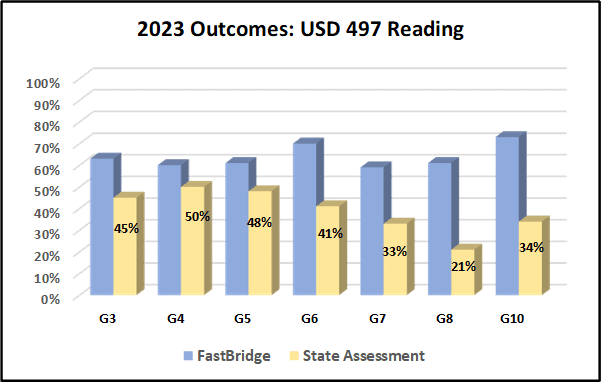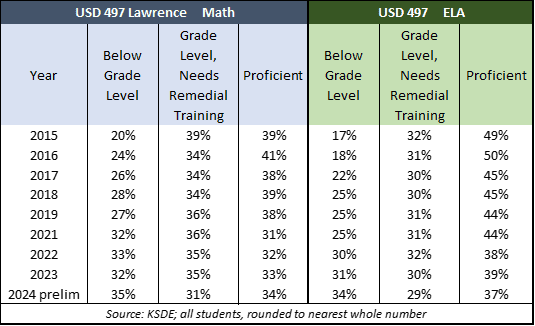Kansas school district deceives school board and parents about reading proficiency
(The Sentinel) – According to the Lawrence Journal-World, USD 497 Chief Academic Officer Patrick Kelly announced at the June 10 board meeting that the Lawrence, Kansas district is very close to…

(The Sentinel) – According to the Lawrence Journal-World, USD 497 Chief Academic Officer Patrick Kelly announced at the June 10 board meeting that the Lawrence, Kansas district is very close to achieving its reading goal of 75%, referencing a chart showing students in some grade levels are over 70%.
As with many claims school districts make about student outcomes, this one isn’t even close to being accurate, but it’s a great example of the extent to which education officials will torture the truth to make the adults in the system look good.
Kelly shared a chart showing the percentage of students in each grade who are “low-risk or on track” on the Spring FastBridge reading assessments. FastBridge is an assessment tool used to monitor academic progress during the year. Kelly didn’t explain what constitutes low-risk or on-track, but it clearly is not the same as the Kansas Department of Education’s definition of “academically prepared for postsecondary.”
The blue-shaded bars in the adjacent chart show the Fastbridge outcomes Kelly shared for 2023. Approximately 70% of 10th-grade students in Lawrence are “low-risk or On-Track,” but the yellow bars reflecting state assessment results show that just 34% are proficient and academically prepared in English Language Arts.

Kelly’s presentation to the Lawrence School Board was upbeat overall, focusing mostly on FastBridge gains. It’s good to celebrate success, but student outcomes won’t improve if the harsh reality of persistently low proficiency levels is ignored.
The sad truth is that outcomes declined in 2024, according to the preliminary state assessment results Kelly shared. In English Language Arts (reading), 34% of Lawrence students are below grade level, compared to 31% last year. Proficiency is also worse, falling from 39% to 37%.
Math proficiency improved a point to 34%, but the share of students below grade level went up 3 points, from 32% to 35%, so overall math results also declined.

Outcomes are worsening despite all the best intentions and hard work that went into the district’s improvement plans. Change is needed, and that’s the purpose of statutorily-required needs assessments for each school. But USD 497, like many other school districts, stubbornly refuses to comply with the law.
Lawrence board members don’t actively participate in building needs assessment
K.S.A. 72-1163 says the local school board “shall conduct” annual needs assessments in each school to answer three questions:
- What barriers are preventing students from being proficient in reading and math?
- What budgetary changes are needed to overcome those barriers?
- With those changes in place, how long will it take for students to become proficient?
Open Records investigations by The Sentinel’s parent company, Kansas Policy Institute, demonstrated that USD 497 did not allow school board members to participate in the building-level meetings, let alone “conduct” them.
Following Kelly’s presentation, Lawrence school board president Shannon Kimball emphatically stated that the district would again not allow board members to conduct the meetings as required by state law.
“(The building needs assessment) is a process that state law requires, but the board has directed the administration to…do this work, in part because there are certain “voices” in our state that want to insist that districts like ours aren’t doing this right because board members are not in the weeds doing Patrick’s job.”
Even if the Lawrence School Board ‘directed’ the administration to conduct the meetings, the board is not fulfilling its legal obligation. Multiple hearings in the House and Senate Education Committees have made this clear—the legislative intent is for board members to have an active role in identifying barriers and the changes to overcome them rather than rubber-stamping a staff-prepared document. Declining student outcomes also indicate that the staff’s handling of the process isn’t working for students.
Here’s one example showing why board participation is critical.
The Kansas School Board Resource Center – another subsidiary of Kansas Policy Institute – trains school board members and provides student-focused guidance. After one training session on the building needs assessment, a board member asked KSBRC to help start the process in his district.
KSBRC Executive Director Ward Cassidy and a board member from a western Kansas district met with an elementary school’s principal, teachers, and other staff members. One teacher volunteered that she didn’t know how to teach kids to read because she hadn’t received that training in college. Pretty soon, all but one teacher said they felt the same. Just one teacher said she was trained in the science of reading.
The principal was shocked, but with that barrier identified, they rearranged the budget to hire another elementary teacher and promote the teacher who is trained in the“science of reading” to coach the other teachers.
It had to be difficult for those teachers to admit to their shortcomings, but the district may never have known of that severe problem if a board member hadn’t taken the initiative to ask.
Defiance like that expressed by Shannon Kimball does students no good. Everyone should adopt the attitude that no one is to blame for low student outcomes, but everyone is responsible for identifying and implementing the changes that need to be made.



